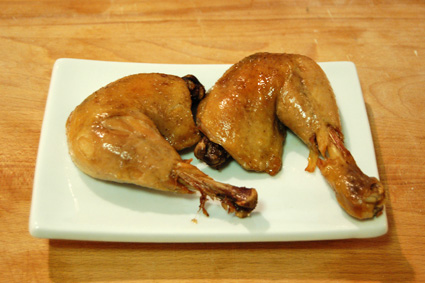
Slow-cooking - be it braising, stewing, slow-roasting, etc. - has a way of transforming raw foods into intensely flavorful dishes. While it's pretty much the only way to cook up tough cuts of meat, like beef cheeks or lamb shanks, it's also a great way to work wonders on vegetables like tomatoes and onions, deepening the flavors by eliminating excess moisture and caramelizing the natural sugars. But confit takes it all a step further.
Confit, originally a French method for preserving meat - as Harold McGee notes, the word "comes via the French verb confire, from the Latin conficere, meaning 'to do, to produce, to make, to prepare'" - is still well worth the effort for the rich, flavorful, fall-off-the-bone result. Traditionally it's made with duck or goose, the meat salted and seasoned, then slow-cooked in fat; once cooled, the fat congeals to create an airtight environment that protects the confit for weeks or even months. Confit works for any flavorful cut of meat, though, and with whatever fat or oil is handy. If you happen to have loads of duck fat just lying around, by all means, but the rest of us have to work with what we've got.
Working on a farm that raises chickens means that I've got as much as - if not more than - I can handle, and I'm always looking for new ways1 to prepare it. Especially if it's something that can be readily adapted to non-chicken dishes. (Barbecue pork not being at all like barbecue chicken, for example - but that's something for another time.)
My first attempt was with chicken leg quarters, using a recipe adapted from Charcuterie. I'd roasted up the breast for another dinner, setting aside the legs. After a day's rest, rubbed with salt and spices, I slow-cooked them in lard for hours, then let it all "ripen" in the refrigerator for a week. Just before serving, I roasted the legs in the oven, warming them through while crisping up the skin. Since I forgot to write it down as I did it, here's something close to what I made:
Confit of chicken legsServing suggestions for the confit generally include whatever greens are in season, from a mixed green salad to wilted spinach to Brussels sprouts, but it'd also make for a fine pasta topping, exceptional tacos, or anyplace where an intensely flavored meat works as a seasoning rather than the bulk of a meal. The seasonings, of course, are infinitely varaiable, and can include pink salt for large quantities intended for long-term storage of up to six months. So's the meat, be it chicken, turkey, duck, pork, venison, or whatever sounds good. And the fat's variable, too: duck fat and lard work wonders, but Mark Bittman even uses olive oil for a turkey confit. But, you may ask, why go to all this trouble? As Ruhlman notes in Charcuterie:
Note: ingredients are scaled per pound of meat
IngredientsDirections
- 1 lb. Chicken leg quarters
- 8 grams kosher salt
- 1 bay leaf, crumbled
- 3 juniper berries, smashed
- 1/4 teaspoon coarse black pepper
- 1/8 teaspoon ground cloves
- Lard as needed
- Sprinkle the chicken evenly all over with the salt, and place in a nonreactive container.
- Mix the spices together and spread over the chicken. Cover with plastic wrap and refrigerate overnight, up to 48 hours.
- Rinse under cold water, wiping off the seasonings. Pat dry.
- Preheat the oven to 200°F.
- Place the leg quarters in a pot, in one layer or two; be sure that you have enough fat to cover the meat completely. Cover with fat and bring to a simmer over medium-high heat, then transfer to the oven. Cook until the legs are completely tender and the fat has become clear, from six to ten hours.
- Remove from the oven and cool to room temperature in the pot; then refrigerate. If the chicken is not completely submerged in fat, add additional melted lard to cover. Store, covered, for up to a month.
- To serve, remove from the refrigerator several hours ahead to allow the fat to soften. (If the fat is too firm, the legs may tear apart as you try to remove them.) Preheat the oven to 425°F.
- Remove the legs from the fat. Place on a baking sheet and roast until the meat is warmed through and the skin is crisp, about 15 to 20 minutes. Alternately, sear in a hot pan to crisp the skin, then finish in the oven, 5 to 10 minutes.
"I asked a chef friend, a teacher expert in the ways of preservation, Dan Hugelier, why now, given that we can 'preserve' food fine in a fridge or freezer or in Cryovack, sealed in oxygenless packages, why was confit ... still relevant? Dan looked at me as if I were an idiot and said, 'Taste.'"* * * * *
1Not that roast chicken and barbecued chicken don't get a strong showing. And fried chicken, and chicken soup, and so on and so forth.

1 comment:
I am attempting this recipe tonight and tomorrow. Of all the recipes I could find, yours looked most interesting. I'll be meddling with the fats, though: Some combination of lard, duck and olive oil, not to mention the chickens' own. Hopefully I won't stumble into a disgusting combination. I plan to introduce garlic cloves into the cooking process too.
Looking forward. Thanks for the recipe.
Post a Comment